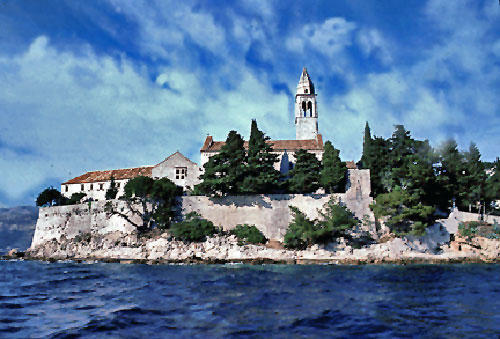Lopud Franciscan Monastery
Site History and Significance
A Centuries-Old Monastery
The islands dotting the Dalmatian shoreline form one of the most beautiful scenic areas of the Adriatic coast. Inhabited since Roman times, the island of Lopud was purchased by the Republic of Dubrovnik in the eleventh century. Because of the island's prominent strategic setting, it became a seat for the republic's governor in 1459, and many noble families built summer estates there.
The Lopud Franciscan Monastery was founded in 1483 on the east side of the island overlooking Lopud bay. By the end of the Croatian War of Independence in 1995, the site was home to a functioning church amidst ruined buildings, former gardens, an unused fortress, and vacant land. Earthquakes, fire, and abandonment had undermined the site's survival, weakening the walls and encouraging rampant vegetation growth.
At that time, national attention focused on the immediate need to resettle refugees, build housing, and repair the social and moral fabric of the country. The rehabilitation of a local site, despite its potential to spark socioeconomic change, was marginalized, and the Lopud Franciscan Monastery faced continued neglect.
Our Involvement
1996 World Monuments Watch
With Croatia's economy in shambles following the Croatian War of Independence (1991–1995), islands such as Lopud held immediate potential for economic growth. The site served as an example of the many fine structures throughout the area that could illustrate the value of adaptive reuse in revitalizing tourism and the local economy.
World Monuments Fund (WMF) included the Lopud Franciscan Monastery on the 1996 World Monuments Watch in an effort to draw attention to the site's deterioration and emphasize the potential for socioeconomic growth that could come from its restoration. Conservation and adaptive reuse of the site would provide a valuable example for the restoration of other sites in the region.
Since the Watch
Following the 1996 Watch, the Save Dalmatia Foundation, with the support of WMF, organized a conference highlighting alternative uses for Lopud and other islands on the southern Dalmatian coast. Attended by the Prince of Wales and Croatia's prime minister, the conference focused attention on the sensitive development of the historic buildings of the area and possible tourism strategies.
In 1997, collector, activist, and philanthropist Francesca Thyssen-Bornemisza set about restoring the Lopud monastery as Creative Director, launching a twenty-year preservation project leading to the site opening its doors in 2020. Today, the fifteenth-century Franciscan monastery has been transformed into Lopud 1483, a contemporary space hosting art, symposia, retreats, cultural events, and private stays, revived as a place for visitors and guests to enjoy once again.
Learn More
World Monuments Fund safeguards cultural heritage around the globe, ensuring our treasured places are preserved for present and future generations.
Sign up for our newsletter to receive regular updates on our projects, stories from the field, upcoming events, and more!
![]()

